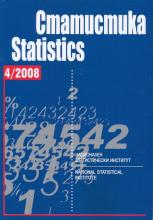National Statistical Institute informs data users that the fourth volume of Statistics Journal, 2008 is issued. The following articles are included:
• Elementary Index Number Theory as a Safe Foundation of a System of National Accounts - author Prof. Venetz Tzonev.
SUMMARY. The author benefits from the fact that at the time when Laspeyres, Paasche and their forerunners shaped the Index Number Theory a fundamental notion like that of set was not known to them. Now, the author benefits also from some approaches used by contemporary statistical agencies (though not fully consistently by the latter) and manages to transform the Index Number Theory into a uniform system based entirely on the notion of set.
• A Sufficient Condition for Single Decisions of Factor Variation at Average Levels - author Emil Hristov, Ph.D. in Economics, senior research fellow, I degree.
SUMMARY. When the average level can be presented as weighted average of sample data, its change for two comparable periods (basic and reported) is due as a common rule to three infl uneces: of changes of sample levels of the observed characteristics, of changes of the relative share of these levels and of the combined but only monodirectional changes of the levels of the relative shares. Through these infl uences the change of the average level could be divided to separate independent parts or effects. Formulated and generalised is one suffi cient condition for single decision which is analogical to the formulated by the author condition at the analysis of the changes of the absolute quantities. According to the author every net effect of the change of certain factor indicator is defi ned by the multiplication of the smaller basic or reported level of the other factor indicator. If the larger level is used, then fi ctive effects will occur, which will mutually neutralise each other but distort the net real effects. In the cases of bidirectional changes there are not combined effects. Proposal is made for continuation of the factor analysis of the changes of the group levels by differences between the temps of changes of their numerators and indicatives.
• Aggregated Production Function of Bulgaria - Cointegrational Approach - author Plamen Petkov, Ph.D., Chief Assistant at “Mathematics and statistics” Department of Academy of Economy “D. A. Cenov” - Svishtov.
SUMMARY. In this article is researched the infl uence of the labour (expressed by the total number of employees and worked manhours) and capital (expressed by the value of the capital, defi ned by using three scenarios - gross capital formation, gross fixed capital formation and consumption of capital) over the production (expressed by gross value added and GDP) in Bulgaria for the period of first quarter of 2000 up to the second half of 2008. For the purposes of the analysis of the long term relations is applied the maximum plausible cointegration approach of Johansen, and for the analysis of the short term dynamics - the models with mechanism of correction of mistakes. The results indicate that the production, labour and capital are cointegrated within six combinations without taking under consideration the seasonal influence and in five combinations when in the models are used fictive centralised seasonal variables. With the combinations without taking into account the seasonal factors it is concluded that in Bulgaria through the researched periode is available declining return of the changes in dimention of the production. The elasticity of capital is between 0.26 and 0.41% and the one of labour - between 0.05 and 0.33%. When models include fictive seasonal variables, it is observed increasing return of the changes in the dimention of the production, and the reason for that is the labour factor, which elasticity is estimated between 0.33 to 1.24%. Elasticity of production towards the capital is from 0.43 to 0.87%.
• Methodological Changes of the Sixth Edition of the IMF’s Balance of Payments and International Investment Position Manual - authors Diana Marinova, Ph.D. at “International economic relations and business” Department of University of National and World Economy, Sofia, and Hristo Genadiev, Ph.D. at “Statistics and econometrics” Department of University of National and World Economy, Sofia.
SUMMARY.Statistics of the external sector, presented by two major statistical reports “Balance of Payments and “International investments position” that are reflecting the transactions and positions of the residents in one country in relation to the residents of the rest of the world. It is important source of information for the intercourse between the worldwide economies. IMF Manual for compilation of statistics of external sector was revised in December 2008 by publication of the “Sixth edition of the IMF’s balance of payments and international investment position manual”. In this article are made observations of the changes in the methodology and the major reasons for the update. The structure of the presentation includes: common observe of this type of statistics and directions for its compilation, changes of the fundamental accounting principles, definitions and classifications; changes in the “Balance of Payments” and “International investments position” accounts; introduction of the practices of the Sixth edition of the Manual.
The annual subscription price (4 issues, including mailing costs) amounts to EUR 20. Price per issue - EUR 7. Prices include VAT.
Subscriptions at the following address:
National Statistical Institute
Publications Division
2, Panayot Volov St.
1038 Sofia
Bulgaria
e-mail: [email protected]
Purchase by bank transfer:
NSI Bank Account
Bulgarian National Bank
Knyaz Alexander Battenberg Square, Sofia
IBAN BG84 BNBG 9661 3000 1190 01
BIC BNBGBGSD



